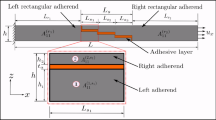Abstract
In this paper, the failure behavior of SiC fiber-reinforced Ti-6Al-4V matrix composite (SiCf/Ti) under longitudinal loads was studied experimentally and theoretically. Experimental results show that the interface of SiCf/Ti composite is continuous and integral. Through SEM observations, it was found that transverse matrix cracks initiated from the debonding region of the interface. A three-dimensional representative volume element was developed to simulate the failure process of SiCf/Ti-6Al-4V composite. A continuum cohesive zone model is employed to describe the debonding behavior at the interface, compared with a discrete one. More accurate simulated results were obtained by a continuum cohesive zone model, corresponding to experimental results. The transverse cracking behavior of the matrix was simulated. The stress–strain curves predicted by the continuum cohesive zone model show a good agreement with the experimental results. The fiber volume fraction, interface strength and interface toughness are investigated to exhibit their influences upon the longitudinal mechanical characteristics of SiCf/Ti-6Al-4V composite.

















Similar content being viewed by others
References
J.W. Chen, H. Huang, and X.B. Liu, Application Progress of SiC Fiber Reinforced Titanium Matrix Composites in Aero Engine, Hi-Tech Fiber Appl., 2015, 40, p 29–32
X.C. Dai, P.F. He, and S.W. Zhai, Development and Research of Metal Matrix Composites in the Engine, Technol. Dev. Enterp., 2015, 14, p 64–65
G.H. Wu, Development Challenge and Opportunity of Metal Matrix Composites, Acta Mater. Compos. Sin., 2014, 31, p 1228–1237
J.M. Tang, Current Status and Prospects of Aerospace Materials, Spacecr. Environ. Eng., 2013, 30, p 115–121
Y. Wang, X.L. Zhu, Y.Q. Zhu, and Q. Yao, A Review on Metal Matrix Composites, China Stand., 2013, 47, p 33–37
G.Q. Zhang, M. Zhao, S. Lu, S. Zhang, and T.S. Shang, Development of Research on Aeroengine Bling Structure, Aeronaut. Manuf. Technol., 2013, p 50–54
D. Giuliano and H.F. Chen, Micromechanical Modeling on Cyclic Plastic Behavior of Unidirectional Fiber Reinforced Aluminum Matrix Composites, Eur. J. Mech. A Solids, 2016, 59, p 155–164
C.W. Zhou, W. Yang, and D.N. Fang, Cohesive Interface Element and Interfacial Damage Analysis of Composites, Acta Mech. Sin., 1999, 3, p 117–122
M.M. Aghdam and S.R. Falahatgar, Micromechanical Modeling of Interface Damage of Metal Matrix Composites Subjected to Transverse Loading, Compos. Struct., 2004, 66, p 415–420
Y.Q. Lian, Mesoscopic Mechanics Analysis of Fiber Reinforced Metal Matrix Composites with Weak Interfacial Bonding, M.S. Thesis, Nanjing University of Aeronautics and Astronautics, 2004
L.G. Huang, Cohesive Zone Model Analysis and Finite Element Subroutine Development, M.S. Thesis, Zhengzhou University, 2010
V.I. Kushch, S.V. Shmegera, P. Brøndsted, and L. Mishnaevsky Jr., Numerical Simulation of Progressive Debonding In Fiber Reinforced Composite Under Transverse Loading, Int. J. Eng. Sci., 2011, 49, p 17–29
W.T. He, Discrete Cohesive Zone Model and Its Application, M.S. Thesis, Huazhong University of Science and Technology, 2013
A.V. Danial, B.N. Legarth, and C.F. Niordson, Micromechanical Modeling of Unidirectional Composites with Uneven Interfacial Strengths, Eur. J. Mech. A Solids, 2013, 42, p 241–250
H.S. Lei, Z.Q. Wang, B. Zhou, L.Y. Tong, and X.Q. Wang, Simulation and Analysis of Shape Memory Alloy Fiber Reinforced Composite Based on Cohesive Zone Model, Mater. Des., 2012, 40, p 138–147
Q. Xu and S.X. Qu, Irreversible Deformation of Metal Matrix Composites: A Study via the Mechanism-Based Cohesive Zone Model, Mech. Mater., 2015, 89, p 72–84
R. Dimitri, M. Trullo, L. De Lorenzis, and G. Zavarise, Coupled Cohesive Zone Models for Mixed-Mode Fracture: A Comparative Study, Eng. Fract. Mech., 2015, 148, p 145–179
S.M. Ruan, Research on Strength Analysis Method of Metal Matrix Composites, M.S. Thesis, Nanjing University of Aeronautics and Astronautics, 2014
T. Wang, Y. Zhao, and S.H. Fu, Research Progress and Key Problems of Continuous Fiber Reinforced Metal Matrix Composites, J. Aeronaut. Mater., 2013, p 87–96
Standard Test Method for Tensile Properties of Fiber Reinforced Metal Matrix Composites Materials, D3552-12, American Society For Testing, 2012
Standard Test Method for Monotonic Tensile Behavior of Continuous Fiber-Reinforced Advanced Ceramics with Solid Rectangular Cross-Section Test Specimens at Ambient Temperature, C1358-05, American Society For Testing, 2000
Y.Q. Yang, Z.J. Ma, J.K. Li, X.H. Lv, and Y.L. Ai, Interface Reaction and Its Effects on Mechanical Property of SiC_f/Super_2 Composites, Rare Met. Mater. Eng., 2006, 35(1), p 43–46
Z.G. Sun, Y.D. Song, and Y.Q. Nian. Weak Interfacial Bonding Effect on the Properties of Composite Materials, J. Aerosp. Power., 2005, p 915–919
Z.G. Sun, H.Y. Shao, X.M. Niu, and Y.D. Song, Failure Simulation of Unidirectional Fiber-Reinforced Ceramic Matrix Composites Based on Evolving Compliant Interfacial Debonding Model, Mater. Sci. Eng. A, 2016, 663, p 78–85
J.K. Li, Y.Q. Yang, M.N. Yuan, X. Luo, and L.L. Li, Effect of Properties of SiC Fibers on Longitudinal Tensile Behavior of SiCf/Ti-6Al-4V Composites, Trans. Nonferrous Met. Soc. China, 2008, 18, p 523–530
J.H. Lou, Y.Q. Yang, Q. Sun, J. Li, and X. Luo, Study on Longitudinal Tensile Properties of SiCf/Ti–6Al–4V Composites with Different Interfacial Shear Strength, Mater. Sci. Eng. A, 2011, 529, p 88–93
Z.H. Xia, Y.F. Zhang, and F. Ellyin, A Unified Periodical Boundary Conditions for Representative Volume Elements of Composites and Applications, Int. J. Solids Struct., 2003, 40, p 1907–1921
Acknowledgments
This work was supported in part by National Basic Research Program of China, National Natural Science Foundation of China (51675266), Aeronautical Science Foundation of China (2014ZB52024), and the Fundamental Research Funds for the Central Universities (NJ20160038), the 2016 graduate innovation base (Laboratory) open fund (kfjj20160213), Foundation of Graduate Innovation Center in NUAA (no. kfjj20170208), Foundation of Graduate Innovation Center in NUAA (no. kfjj20170220) are gratefully acknowledged.
Author information
Authors and Affiliations
Corresponding author
Rights and permissions
About this article
Cite this article
Sun, Z., Sun, J., Chang, Y. et al. Axial Tensile Failure Analysis of SiCf/Ti Composite Based on Continuum Cohesive Zone Model. J. of Materi Eng and Perform 28, 956–966 (2019). https://doi.org/10.1007/s11665-018-3624-z
Received:
Revised:
Published:
Issue Date:
DOI: https://doi.org/10.1007/s11665-018-3624-z




